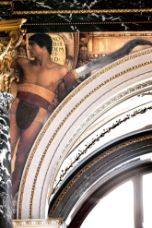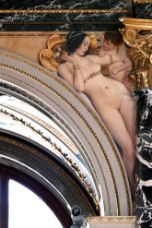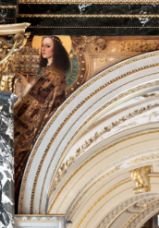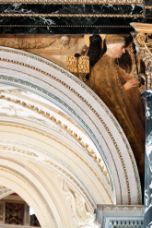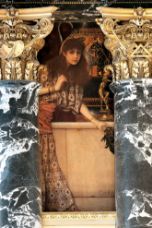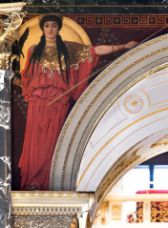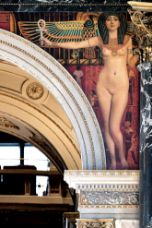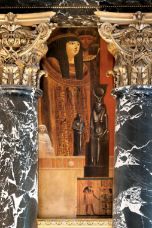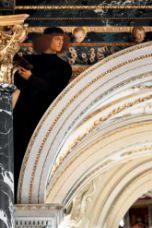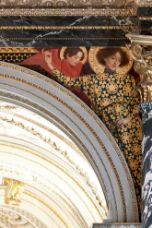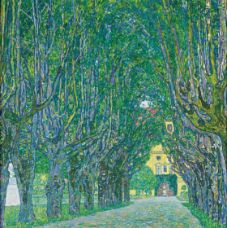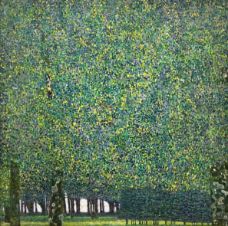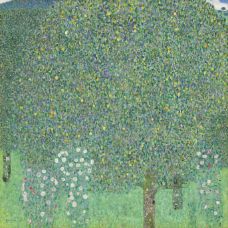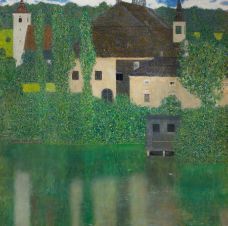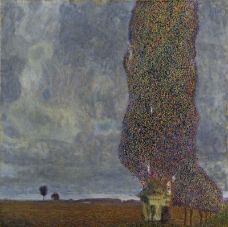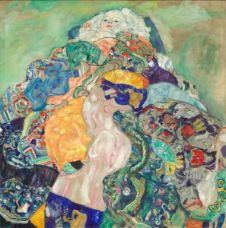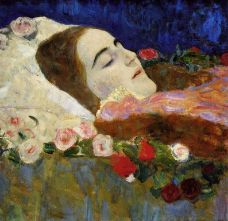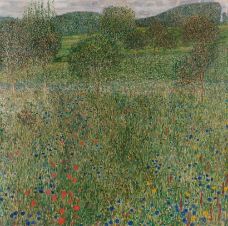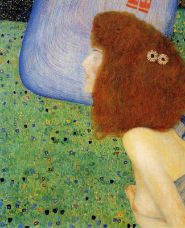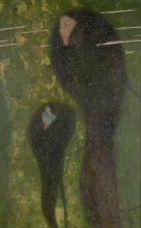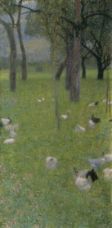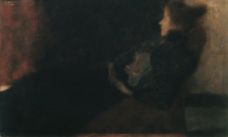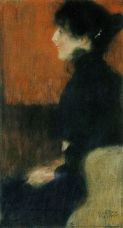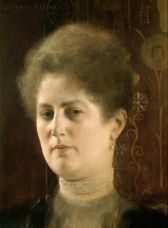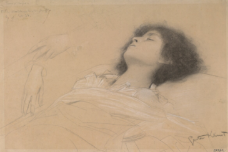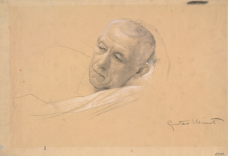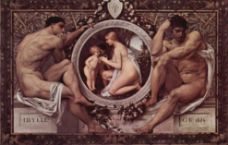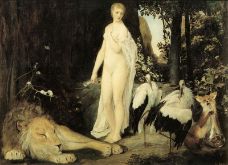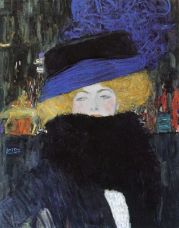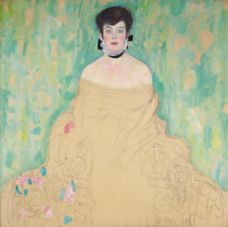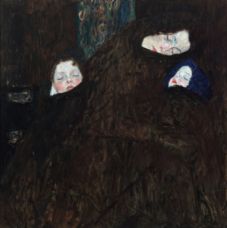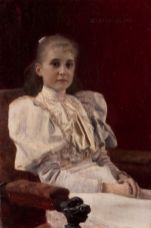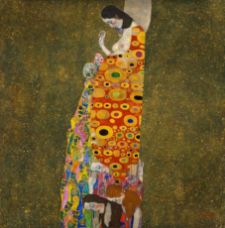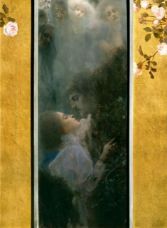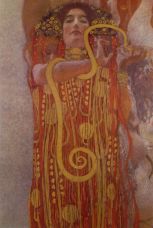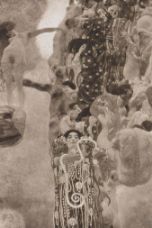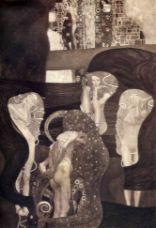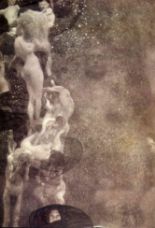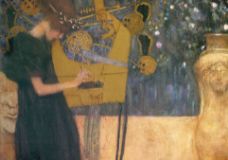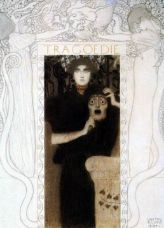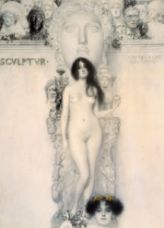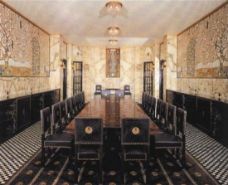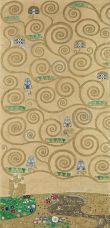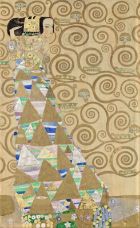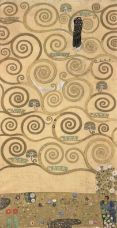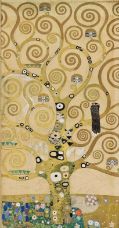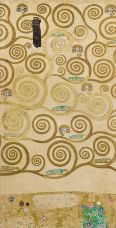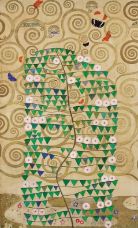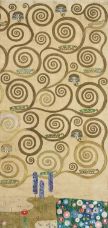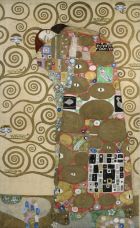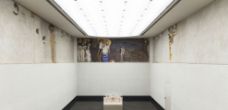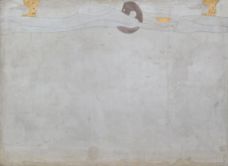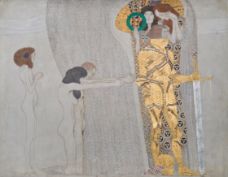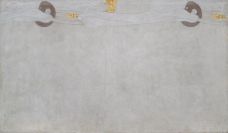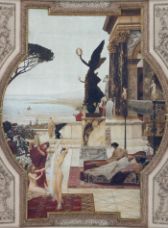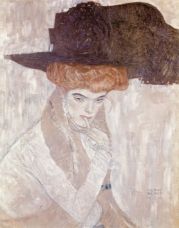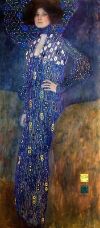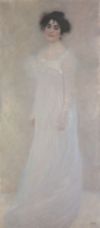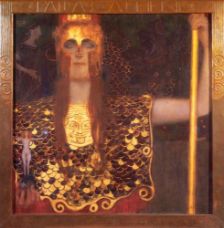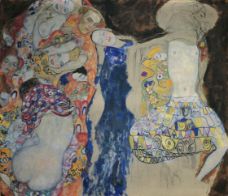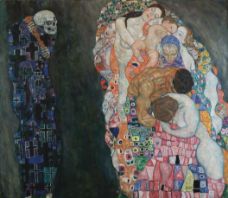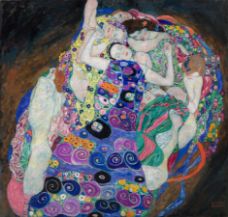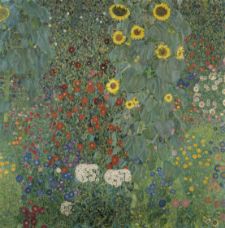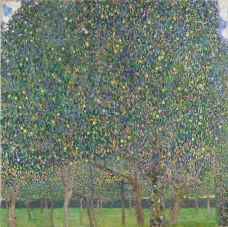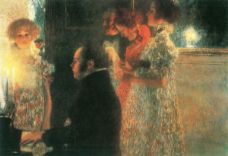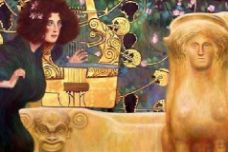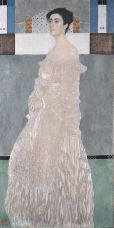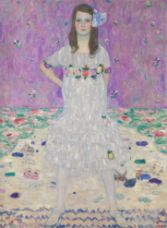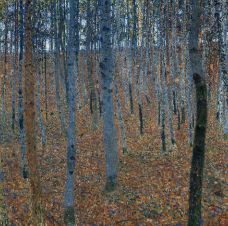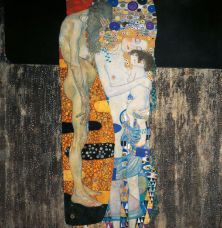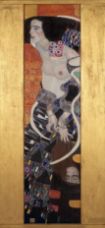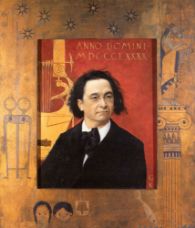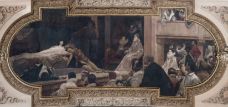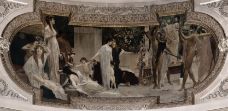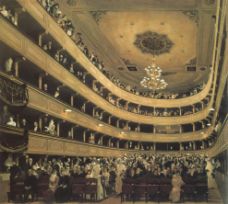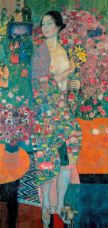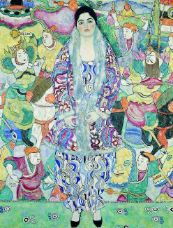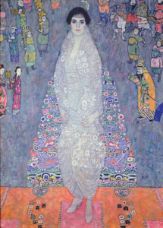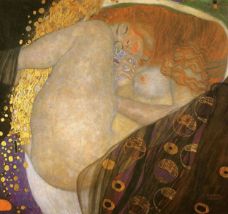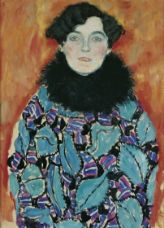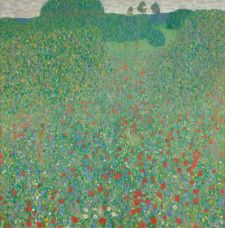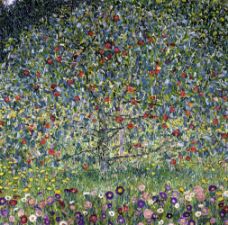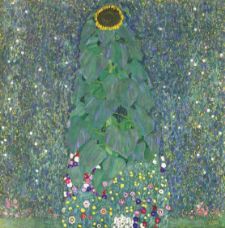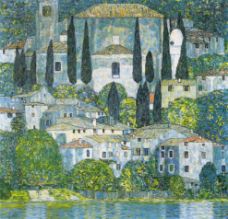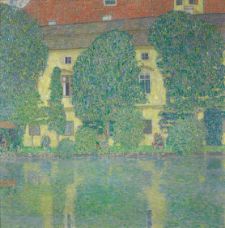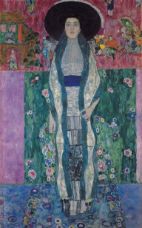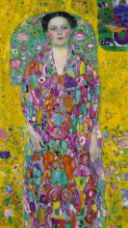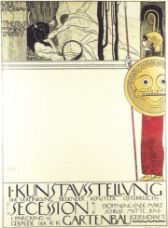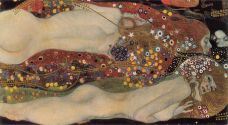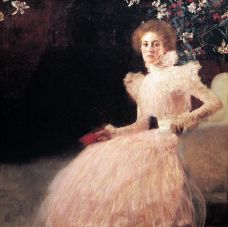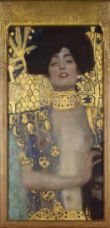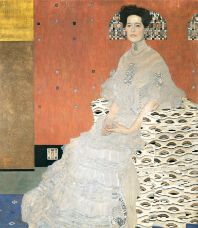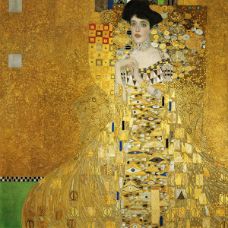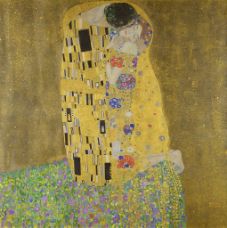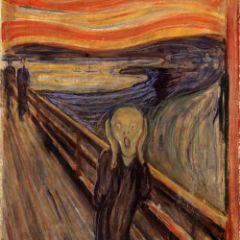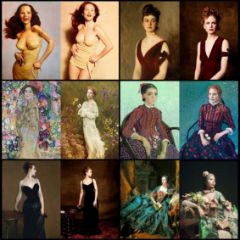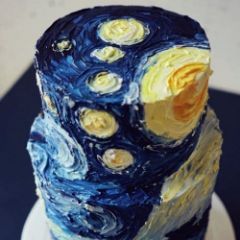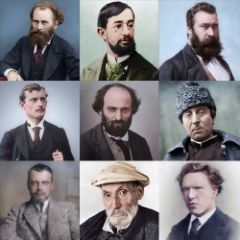The most well-known paintings in the history of art have been reconsidered from a different point of view. Famous paintings of world-renowned painters have been reinterpreted by a photo shoot with Nicole Kidman, Julianne Moore, Jessica Chastain, Naomi Campbell, Laetitia Casta, and Nicki Minaj. Photo shoots for Johannes Vermeer, John Singer Sargent, François Boucher, Gustav Klimt, René Magritte ...
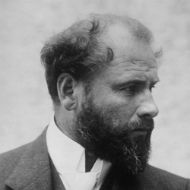
Gustav Klimt
Gustav Klimt was born on July 14, 1862, in Baumgarten, near Vienna. He was the second of seven children of Anna Finster and the gold engraver Ernst Klimt. Klimt and his brothers Ernst and Georg, like their father, showed that they had the artistic ability at an early age.
After eight years of primary education, at the age of 14, he entered the School of Applied Arts (Kunstgewerbeschule), one of the leading fine arts schools in Vienna. In 1877, his brother Ernst attended the same school. Klimt and his brother became close friends with Franz Matsch, another painter there. As a student of Professor Ferdinand Laufberger, one of Vienna's most important names, together with his brother and Matsch, he spent seven years studying various techniques such as mosaics, paintings, and frescoes. The three of them worked very well together, Laufberger found design works for them from the outside.
From 1880 onwards, they started to work with their signatures. Three young people founded the Company of Artists (Künstlercompagnie) in 1883. In 1886, they received the decoration work of the new City Theater (Burgtheater) in Vienna, the first important order. They were tasked with depicting scenes from the history of theater in the pediment of the building and the ceiling of the staircase. Klimt's work revealed a different work than his friends. He added realistic portraits to the perfection of the photo beside the classical motifs. Thus, he added distinctive features to his paintings from his period such as “The Theater in Taormina”. At the same time, before the disappearance of the Old City Theater, he received the offer to paint the inside of the theater and paint the people of the high society in Vienna. After accepting this work, the gouache painting called "Old City Theater Auditorium" which he remained faithful to the photographic view had appeared. The group received praise on both the decoration of the stairs and the work of Klimt. Klimt was awarded the gold medal by Emperor Franz Joseph in 1888 for this work.
They received an order in 1890, which showed of the Artists Company that they got themselves accepted. This order was the completion of the interior decoration of the Art History Museum (Kunsthistorisches Museum’un), where the imperial collections would be exhibited. In the museum, the art history of ancient Egypt, 16th century Florence, was thought to be described. This work was first given to Hans Makart (1840-1884), one of the masters of the historical movement. Klimt and his friends had successfully completed the stairs ornaments that were left unfinished due to the death of Makart. A new element that Klimt uses has been the harbinger of his future style. With a contemporary female figure study in her historical costume, Klimt had differentiated from his partners in style and had moved away. Three friends started to get portrait works, and this led to the spread of Klimt's reputation. The accuracy of the photographs in portrait depictions would always remain the main feature of Klimt.
Klimt lost his father and brother Ernst in 1892 and entered a deep personal and artistic crisis period. This situation also caused the collapse of the Artists Company. At the same time, he had started seeing Emilie Flöge. Klimt had met her in 1890 during the marriage of his brother Ernst to Emilie's sister. After the death of Ernst, the relationship between the two became stronger and Emilie had been with him throughout Klimt's art life.
In 1897, a divergence occurred in the Vienna art scene. Some artists, including Klimt, were separated from the Chamber of Artists (Künstlerhaus). Young generation artists aimed to show their work in a suitable place that would not be affected by market forces, to break Vienna's cultural loneliness, to invite foreign artists to the city and to promote the work of their members in other countries. The basis for the attitude to be called Secession had been laid. Not only painters but also sculptors and architects participated in this. As a founding member of Secession, Klimt was elected president.
In 1898, they published the Sacred Spring (Ver Sacrum) magazine, which will be the organs of communication at the same time Klimt contributed regularly for two years.
In order to fully realize their ideals, the Secession group needed an appropriate exhibition center. This need was solved under the leadership of architect Joseph Maria Olbrich, one of the founders of Secession. The first exhibition of the Group opened in March 1898. Klimt participated in the exhibition with a poster of Theseus and Minotauros from the classical mythology loaded with intense symbolic meanings. The poster was censored because of the clearly illustrated figures. He had to add a tree motif to the painting to overcome this censorship barrier.
In this period, the work of “Pallas Athena”, the first superior female-themed work, was controversial. New elements, such as the use of gold in this table and the transformation of human anatomy into an ornament, would be the determinant of Klimt's later work. He did “Portrait of Sonja Knips” in the same period. This painting was also the beginning of a series of society women who would provide economic prosperity. Klimt, who used male and female figures equally in his previous works, would then make only female figures.
In 1894, the government had ordered Klimt to decorate the ceiling of the large hall of the University of Vienna. The subjects of the tables were thought to a representation of the allegories of the Faculties of Philosophy, Medicine, and Law and to glorify the rational sciences.
When he presented the unfinished Philosophy to the public in 1900, the reactions of the academy and the press had been severe. The artist was accused of obscenity and artistic insufficiency, and also the next two of his works were harshly debated. In 1904 Klimt returned the wages of these criticized works and decided to take back his works. After the scandal created by the university project, these paintings had been his last work on behalf of the state. These discussions would have resulted in his making a radical decision. He would not take part in public service.
1902 was important for both the Secession group and Klimt. The Beethoven exhibition was held in the Sezession Palace. The exhibition was the celebration of a single work by Max Klinger, a statue of the German composer. For this exhibition, Klimt created “The Beethoven Frieze” consisting of three gypsum panels. The three walls depicted were forming an array. The first long wall opposite the entrance was "The Yearning for Happiness", on the last wall was "The Hostile Forces" and on the second longwall "The Longing for Happiness Finds Repose in Poetry".
After these works in memory of Beethoven, Belgian industrialist Adolphe Stoclet commissioned Josef Hoffmann and Klimt to decorate the wall of the house in Brussels. Klimt decorated the wall with marble mosaics consisting of three parts decorated with gold enamel and precious stones. The nine panels of Klimt's frieze included abstract motifs, stylized motifs, and figurative works. In this study, Klimt's mastery of the mosaic had reached his peak. He re-discovered this technique, which he had learned in the School of Applied Arts, in his trip to Ravenna, Italy, in 1903. The girl who danced under one of the trees was symbolized Expectation, and the couple who were embraced under the other tree symbolized the Reconciliation. The same motif would soon appear in the famous "The Kiss" picture, which represents the peak of Klimt's golden age. Klimt's golden era, which he used as intense use of gold, began with “The Portrait of Fritza Riedier” dated 1906 and reached his peak with “The Portrait of Adele Bloch-Bauer I” dated 1907, which he most intensely used the gold color. These portraits were also the most important female portraits of the artist.
Eighteen artists, including Klimt in 1905, left Secession due to disagreements. He did not disrupt these rupture works and made the first big size "Three Ages of Woman" painting in the same year. This painting was also a transition to multi-figured women's subjects.
Klimt and his friends established a new community called Kunstschau after the separation of the Secession. Three years later, the group held its first exhibition. Klimt's last works were included in the exhibition, and the Expressionist painter Oscar Kokoschka was also welcomed. In 1909, the community would open its second and last exhibition. In this exhibition, the works of Edvard Munch, Pierre Bonnard and Henri Matisse, as well as the works of the young artist Egon Schiele, who considered Klimt a master, would also be exhibited. Klimt thought of transferring the richness of expression of the works in the exhibition to his works; later the same year went to Paris, where he discovered Henri Toulouse-Lautrec and the works of the fovists. As a result of these encounters, he adopted a more diverse range of colors and created a composition resembling a kaleidoscope. He decided to relieve the decorations and decor by leaving the use of gold. Klimt was very impressed by Japanese woodcuts, such as all artists and intellectuals of the period, as a method of reducing the intensity of the décor. He had used Japanese examples in his previous works. In the technical mastery of his paintings with kaleidoscope-like arrangements he had greatly influenced them. With his portraits like “Mäda Primavesi”, important works of his last period appeared. In this table, the anatomy of the model turned into ornaments and ornaments became anatomy. He reached the apex of this new style with his work “ The Dancer". Klimt's new style of work was met with a general appreciation.
Klimt's landscape painting was also evolving. The methods used in the landscape paintings, which make up one-quarter of his paintings, were different from each other. The first period of the landscape paintings with a realistic color harmony had created a very detailed. In his later works, mosaic form works were attracted attention. In general, the horizon and the sky were almost completely lost in landscape paintings and no people were included. He also painted some landscapes, especially in his travels to the northern regions of Italy. In the last period of his landscape paintings between 1915 and 1918, he was directed to darker, monochrome influences instead of vivid colors. This was interpreted by critics as the explosion of World War I in 1914 and the loss of his mother in 1915.
Klimt died on 6 February 1918 as a result of a stroke. The artist was buried in the Hietzing cemetery. The paintings ”Portrait of Johanna Staude“ and ”The Bride" were left unfinished…
Bibliography;
Çev:Kundakçı, D., (2004). Artbook Klimt Altın Renkli Bir Arka Plan ve Sezession, Birinci Baskı, Dost Kitabevi, Ankara.
Lunday, E., (2013). Büyük Sanatçıların Gizli Hayatları, Beşinci Baskı, Domingo Yayınevi, İstanbul.
Cassou, J., (2006). Sembolizm Sanat Ansiklopedisi, Dördüncü Basım, Remzi Kitabevi, İstanbul.
Neret, G., (2006). Klimt, Birinci Basım, Taschen/Remzi Kitabevi, İstanbul.
Bell, J., (2009). Sanatın Yeni Tarihi, Birinci Baskı, NTV Yayınları, İstanbul.
Farthing, S., (2014). Sanatın Tüm Öyküsü, İkinci Baskı, Hayalperest Yayınevi, İstanbul.
-----------. Klimt, Birinci Baskı, Boyut Yayın Grubu, İstanbul.
1862 He was born in Baumgarten near Vienna on July 14th.
1876-83 He entered the School of Applied Arts (Kunstgewerbeschule) in Vienna.
1877 His brother Ernst went to the same school. 1881 The publisher Gerlach has ordered some pictures for the Allegories and Symbols series.
1883 Together with his brother Ernst and the painter Franz Matsch, he founded the Künstlercompagnie.
1886 They took on the decoration work of the newly made Burgtheater, the first important order for Klimt and the Artists Company. Klimt made “Theater in Taormina” and “The Theatre of Shakespeare”.
1888 Emperor Franz Josef awarded Klimt the Golden Medal of Merit for his contributions to the arts. 1890 He made decoration in the staircase section of the Kunsthistorisches Museum in Vienna. Here he made depictions of Greek, Egyptian and medieval antiquity as well as Italian Renaissance.
1892 Klimt's father died in a stroke. In the same year, he lost his brother Ernst. The Artists Company broke up. 1894 Klimt and Matsch were tasked with painting the walls and ceilings of the University Great Hall.
1895 He started working with the publisher Gerlach again. He made works such as Love and Sculpture Allegory.
1897 Klimt, the founding member of Secession, was elected to the presidency. He began to spend the summer months in the Kamer region of Attersee with Emilie Flöge. He made his first landscapes.
1898 The publication organ of the Secession began to publish Ver Sacrum magazine and the first exhibitions were opened. Klimt's Theseus and Minotauros poster and Pallas Athena, the symbol of the Sezession group, led to fierce controversy.
1899 He created another polemic and a sensational piece, Nuda Veritas.
1900 The presentation of Philosophy, the first of faculty painting, to the public launched a fierce debate both at the institutional and the press, but won the gold medal at the World Exhibition in Paris.
1902 In the context of the Beethoven exhibition, which was the most important event in the history of Secession, he made The Beethoven Frieze.
1903 He made a trip to Italy. He went to Venice, Ravenna, and Florence. He was very impressed with the Ravenna mosaics, which were forming the basis for his future research focusing on the use of gold.
1904 Due to the reaction to the faculty's painting, he decided to return the fee and get back his works. He made designs for the wall mosaics of Stoclet Palace in Brussels.
1905 He left the Secession group. In the same year, he made a painting named The Three Ages of Woman. 1906-08 He started Danae and some of his portraits, including Portrait of Adele Bloch Bauer I.
1907 He met young Egon Schiele.
1908 The first Art Exhibition of the Klimt Group was held and was hosting the Expressionist Oscar Kokoschka who exhibited his works for the first time. In the same year, Klimt finished his most famous work, The Kiss.
1909 The second and last art exhibition of the yapıl Klimt Group “was held. This time the work of the young artist Egon Schiele was also exhibited. He went to Paris. He discovered Toulouse-Lautrec and fauvism with great interest.
1911 Death and Life received first prize in the Rome World Exhibition. Klimt went to Rome, Florence, Brussels, London, and Madrid.
1915 He lost his mother. The landscape pictures had become a little more monochrome.
1917 He began to work on his work such as Adam and Eve, The Bride. He was elected as an honorary member of the Academy of Arts in Vienna and Munich.
1918 He died on 6 February as a result of a stroke. Many of his work was left unfinished. The artist was buried in the Hietzing cemetery. Egon Schiele did three portraits after his death.
The Scream - Edvard Munch
In 1893 Edvard Munch began working on his most famous work, "The Scream". The painting was part of a series called "Life Frieze", whose subject matter was life, love, death and the intense emotions they aroused. Munch worked for years on this series, rearranging each time and adding new paints.
Paintings from Cake
Nastasya Chernogrivova, the founder and master of the cake of Marfa Patisserie in Saint-Petersburg, Russia, makes cakes with interesting cakes. Combining his delicious cakes and pastries with world-famous works of art, Dali creates cakes with paintings by famous painters such as Degas, Monet, Klimt and Van Gogh.
Nastasya Chernogrivova, by making all of the cakes on the order to make designs every time again. She shares her unique and unique cake designs from her instagram account "marfa_torts".
Colorized Photos of Painters
On Tumblr.com, a user named "Paintters.co" colorized a lot of the black-white photos of world-famous painters. Examples of this photographic works...
Gustav Klimt's Paintings Revitalization with photo shoots.
Photographer Inge Prader has revived the eye-catching paintings of Gustav Klimt. He revived some of the most iconic works of the Austrian artist using live models.













